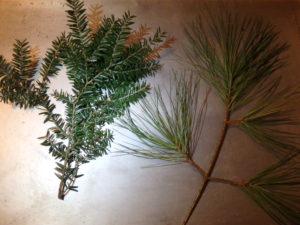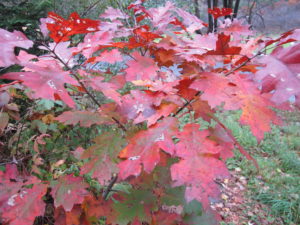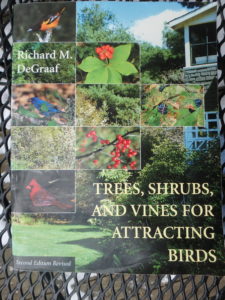Feeding the Birds – Without Buying Seeds
This year, given the plethora of squirrels in the universe, I feel that I should just buy a dump truck-load of black oil sunflower seeds and drop it on the lawn in front of the deck. Then maybe the squirrels would let my timid titmice get to the feeder. Maybe not. But there are other ways to ensure our feathered friends get lunch.
Long before farmers of the mid-West began cultivating sunflowers in mile-long fields, birds survived our winters here. How? They ate the seeds of our native flowers and shrubs, and the little bugs that lived on them. Let’s look at a few trees that birds depend on – not just now, but throughout the year.
Two of the best trees for birds are white pine and Canadian hemlock. Each is used by 25 to 40 species of birds. Some birds eat the seeds. Some use them for shelter, getting out of the winter wind or spending the night nestled safely in the branches. Others build their nests in them. Birds need places for all those things in order to survive.
Unfortunately, both pines and hemlocks grow to be taller than your home, given a couple of decades. White pine (Pinus strobus) grows an average of 2 feet per year, so you shouldn’t plant one near the house. But if you want to block the view of the neighbor’s rusty cars lurking by your property line, several white pines can be nice. They get to be 20 to 40 feet wide, so if you plant them 10 to 15 feet apart, they will fill in the gap nicely.
Canadian hemlock (Tsuga canadensis) will grow in full sun or deep shade, but does not do well in wet, soggy soils. It grows fast, especially in sunny locations. I’ve read that it takes 20 years before the trees start to produce cones – hence food – and then it only does so in 2 or 3 year intervals, not every year. Still, it is great for nesting and protection.
Nut trees of any sort are loved by our birds. You might wonder how acorns can be opened and eaten by small birds like the Carolina wren or white-breasted nuthatch. Think of acorns like money in the bank. No, most birds can’t crack them open when they fall. But a few months on the ground will soften the outer shell. And squirrels are messy eaters. They’ll open a nut, eat some, drop it and go on to the next – leaving plenty of nut meat for an industrious bird. Of course, nut trees take time to reach maturity, but plan now for your grandchildren’s enjoyment when adults.
Berries of any sort are great for birds. Wild grapes, for example, may be a pain if they grow up your favorite decorative tree, but in the woods they are fine. More than 50 species of birds eat the fruit, though that is mainly in the fall. They are beloved by birds we all love – cardinals, orioles and scarlet tanagers, along with the more common woodpeckers, warblers and thrushes.
Wild brambles grow freely along the edges of fields and gardens. Most gardeners think of them as pests and pull them out, but many birds like the fruit – even if it is not as sweet as our cultivated raspberries and blackberries. So let those brambles grow. Since they are thorny, cats are less likely to prowl in brambles, giving protection for nesting birds such as catbirds and vireos, which find them attractive.
Native shrubs are generally better for feeding birds than shrubs imported from Europe or the Far East. Why? Because our birds and our native shrubs evolved together, one adapting to the other. Birds that eat berries from native shrubs such as elderberries, viburnums and native willows and dogwoods produce better food for birds than non-native shrubs.
I don’t cut down all my perennial flowers in the fall. Not because I am lazy or behind on my work (though there is some of that). I leave things like purple coneflower and black-eyed Susans for the finches. Those flower heads are fully of little seeds. My sunflower seeds get eaten by birds in late summer or early fall, so there are none left for winter – except in 20 pound bags.
Winter is a good time for planning. If you like the idea of planting for birds, you should try to locate a copy of Richard DeGraf’s book, Trees, Shrubs and Vines for Attracting Birds. I think it’s out of print, but readily available. This book lists most common native species of trees, shrubs and vines and then specifically lists the birds that use them for food, nesting or cover. Thus if you want to attract cardinals or bluebirds, for example, study the book to see which plants are used by them.
As you reflect on what trees and shrubs to plant, remember that birds need more than food. They need nesting sites, protection from the wind and those sneaky neighborhood cats. There are plenty of native plants that will look good in your landscape, and support our feathered friends, too.
Henry is the author of 4 gardening books. He lives and gardens in Cornish Flat, NH.





